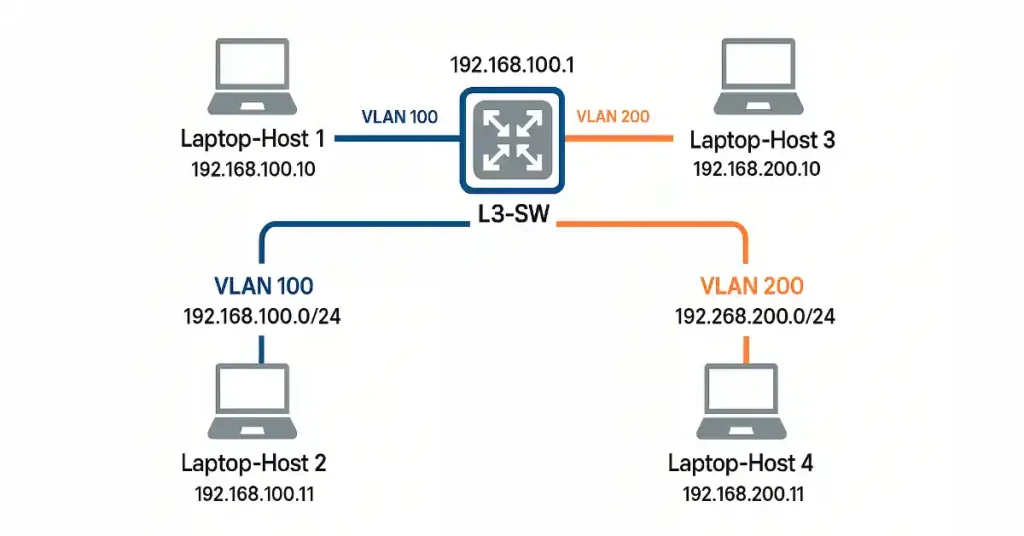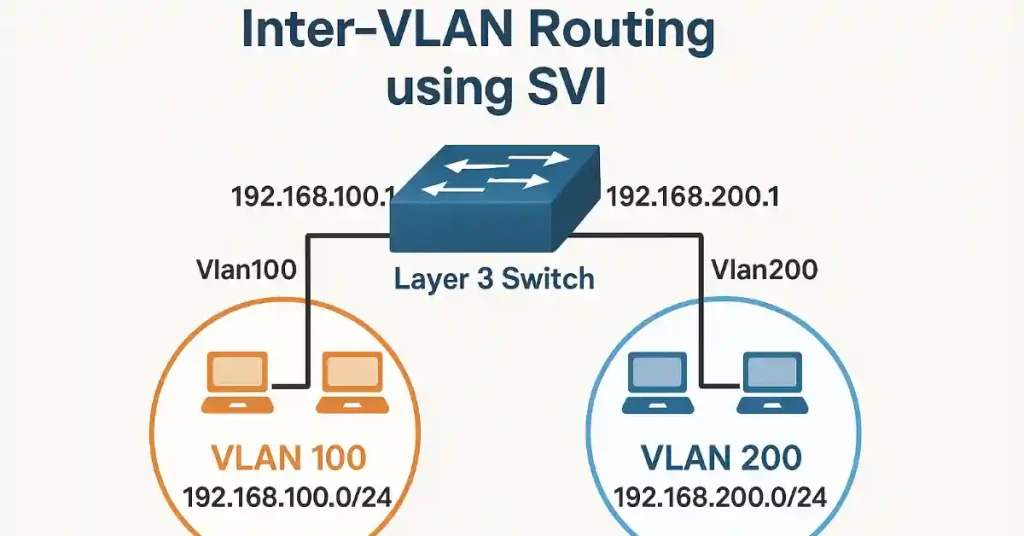Switch Virtual Interfaces (SVIs) are a cornerstone of modern enterprise networking, enabling efficient inter-VLAN routing on multilayer switches. This guide, designed for CCNA and CCNP students, explores the evolution of Layer 2 and Layer 3 switching, SVI configuration, verification, troubleshooting, and real-world applications. Whether you’re preparing for certification exams or deploying networks, this article provides practical insights and examples to master SVIs.
Evolution of Layer 2 and Layer 3 Switching
In early networking, Layer 2 switches were the fastest devices for forwarding data, operating by receiving frames and sending them to other ports based on MAC addresses. Routers, handling Layer 3 routing, were slower due to software-based processing. For CCNA students, this highlights the basics of hierarchical network design (access, distribution, core layers). For CCNP candidates, it ties into advanced topics like OSPF and multilayer switching.
To scale networks, engineers extended Layer 2 switches across access, distribution, and core layers. However, this introduced loop issues, resolved by the Spanning Tree Protocol (STP), which maintains redundancy while preventing loops. As technology advanced, routers became faster and more affordable, enabling wire-speed routing. This shift moved routing functions to the core and distribution layers, reducing reliance on STP.
Transition to Layer 3 in Core and Distribution
Routers were moved to the core and distribution layers without compromising performance, as modern switches began supporting Layer 3 routing. Users are segmented into VLANs and subnets, with distribution switches acting as Layer 3 gateways for access layer VLANs. Each distribution switch requires a unique IP address per VLAN, and Layer 3 routed ports connect distribution to core switches. This design eliminates physical Layer 2 loops, reducing STP dependency.
| Layer | Device Role | Benefits |
|---|---|---|
| Access | Layer 2 Switches | User connectivity, VLAN assignment |
| Distribution | Layer 3 Switches (SVIs) | Inter-VLAN routing, gateway for VLANs |
| Core | Layer 3 Routers/Switches | High-speed routing, no STP loops |
This hierarchical model is critical for CCNP students studying campus network design and scalability.
What is a Switch Virtual Interface (SVI)?
An SVI is a virtual Layer 3 interface on a switch, associated with a specific VLAN. Unlike physical ports, SVIs enable routing and gateway functions without external hardware. SVIs are supported on both Layer 2 and Layer 3 switches:
- Layer 2 Switches: Use SVIs for management (e.g., Telnet/SSH access).
- Layer 3 Switches: Use SVIs for inter-VLAN routing and dynamic routing protocols like OSPF.
SVIs provide Layer 3 processing for all hosts in their associated VLAN. To function, the VLAN must exist in the switch’s database. For example, to create VLAN 100:
Switch(config)# vlan 100
Switch(config-vlan)# name ManagementIf the VLAN is missing, the SVI remains down, a common issue tested in CCNA labs.
Why Use SVIs?
SVIs are essential for modern networks due to their versatility:
- Gateway for VLANs: Provide IP connectivity for VLAN hosts (e.g., 192.168.100.1 for VLAN 100).
- Layer 3 Connectivity: Enable switch management and routing.
- Routing Protocol Support: Facilitate protocols like OSPF for dynamic routing in CCNP scenarios.
- Bridging Configurations: Support integrated Layer 2/3 operations.
Configuring Inter-VLAN Routing with SVIs
Consider a topology with two VLANs (100 and 200) requiring inter-VLAN routing on a Cisco multilayer switch (e.g., Catalyst 9300). Below are the steps, including prerequisites, to configure SVIs.
Prerequisites
Create VLANs in the switch database:
L3-SW(config)# vlan 100
L3-SW(config-vlan)# name Users
L3-SW(config)# vlan 200
L3-SW(config-vlan)# name ServersAssign ports to VLANs:
L3-SW(config)# interface fa0/1
L3-SW(config-if)# switchport mode access
L3-SW(config-if)# switchport access vlan 100
L3-SW(config)# interface fa0/2
L3-SW(config-if)# switchport mode access
L3-SW(config-if)# switchport access vlan 200
We can configure a switch virtual interface (SVI) for both a multilayer switch and a Layer 2 switch for a VLAN that exists on that switch. However, only the multilayer (layer 3 supported) switch can do inter-VLAN routing.
The Switch Virtual Interface is not a physical port; therefore, it’s called a virtual interface. It functions on a multilayer switch like a router interface and can be configured similarly.
The SVI provides layer 3 processing for packets to all associated hosts of that VLAN. Whenever you want to configure the SVI, ensure that the particular VLAN exists on the switch.
In the figure above, the switch must have VLAN 100 and VLAN 200 in the VLAN database; if not, the SVI interface stays down. We required SVI for the following reasons.
- To offer a gateway for a VLAN.
- Providing Layer 3 IP connectivity to the switch
- To support routing protocol and bridging configurations
The topology consisting of two VLANs required inter-VLAN routing using a switch virtual interface (SVI). The configuration steps are the following.
L3-SW(config)# ip routing L3-SW(config)# interface vlan 100 L3-SW(config-if)# no shutdown L3-SW(config-if)# ip address 192.168.100.1 255.255.255.0 L3-SW(config)# interface vlan 200 L3-SW(config-if)# no shutdown L3-SW(config-if)# ip address 192.168.200.1 255.255.255.0
Note:- The ip routing command activates Layer 3 routing, allowing the switch to build a routing table for VLANs. For external connectivity, add a default route:
We enable routing on the switch using “IP routing.” If routing is not enabled on the switch, we can’t communicate with other VLANs. With this command, the switch builds its routing table over the IP address information on its virtual interfaces.
We can verify the IP routing configuration using the “show ip route” and “show startup-config” commands. The figure below illustrates the switch routing table.
Routing table before the “IP Routing” command
L3-SW# show ip route Default gateway is not set Host Gateway Last Use Total Uses Interface ICMP redirect cache is empty L3-SW#
Routing table after “ip routing” Command
L3-SW# show ip route
Codes: C - connected, S - static, R - RIP, M - mobile, B - BGP
D - EIGRP, EX - EIGRP external, O - OSPF, IA - OSPF inter area
N1 - OSPF NSSA external type 1, N2 - OSPF NSSA external type 2
E1 - OSPF external type 1, E2 - OSPF external type 2
i - IS-IS, su - IS-IS summary, L1 - IS-IS level-1, L2 - IS-IS level-2
ia - IS-IS inter area, * - candidate default, U - per-user static route
o - ODR, P - periodic downloaded static route
Gateway of last resort is not set
192.168.100.0/24 is directly connected, Vlan100
192.168.200.0/24 is directly connected, Vlan200
L3-SW#
As I said earlier, we can configure the switch virtual interface (SVI) interface for both Layer 3 and Layer 2 switches, but the difference is the “ip routing.” On layer 2 switches, we use the switch virtual interface (SVI) only for remote switch management.
We can verify the interface configuration by using the “show ip interface brief” command. Just like we use the command for router interface verification.
The command will show all ports and the switch’s virtual interface. We can also use the “show interfaces” command to see all ports and the VLAN interface. If we want the required interface, we can use the command with interface ID, such as “show interfaces vlan 100”, this command will only display the settings of interface VLAN 100. For the other commands, you can read my earlier articles.
Advantages
- The switch virtual interface (SVI) is faster than router-on-a-stick because everything is hardware-switched and routed.
- It does not require any external links from the switch to the router for routing.
- In this method, the limitation of one link is overcome because we can use Layer 2 Ether Channels between the switches to get more bandwidth.
Disadvantages
The only disadvantage of layer 3 switches is that they are too costly.
Conclusion
SVIs are a powerful feature for inter-VLAN routing, offering performance and flexibility in modern networks. By mastering SVI configuration, verification, and troubleshooting, CCNA and CCNP students can excel in exams and real-world deployments. Practice these commands in a lab environment to solidify your understanding.
What is a Switch Virtual Interface (SVI)?
A Switch Virtual Interface (SVI) is a virtual Layer 3 interface on a switch, associated with a VLAN, that provides routing for packets between VLANs. It acts like a router interface but is configured on multilayer switches for inter-VLAN communication, offering gateways, IP connectivity, and support for routing protocols. Unlike physical ports, SVIs require the VLAN to exist and “ip routing” enabled for full functionality.
How do you configure SVI for inter-VLAN routing?
To configure SVI, enable “ip routing” on the Layer 3 switch. Create interfaces like “interface vlan 100” with “ip address 192.168.100.1 255.255.255.0” and “no shutdown”. Repeat for other VLANs. Verify with “show ip route” to see connected networks in the routing table, ensuring VLANs are in the database for the interface to come up.
What are the advantages of using SVI?
SVI is faster than router-on-a-stick due to hardware switching, eliminates external router links, and supports Ether Channels for increased bandwidth. It reduces dependency on spanning tree by avoiding Layer 2 loops, enhances performance in core/distribution layers, and provides flexible inter-VLAN routing without performance hits.
What is the difference between SVI on Layer 2 and Layer 3 switches?
On Layer 3 switches, SVI enables inter-VLAN routing with “ip routing” for building routing tables. On Layer 2 switches, SVI is limited to remote management without routing capabilities. Both require VLAN existence, but only multilayer switches process Layer 3 packets across VLANs.
How can you verify SVI configuration?
Use “show ip route” to check routing table entries for connected VLANs. “Show ip interface brief” lists SVI status and IPs. “Show interfaces vlan [ID]” details specific VLAN interface settings. Before “ip routing“, the table shows no gateways; after, it displays connected networks like 192.168.100.0/24.





